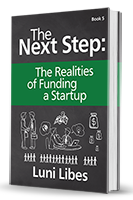A sliver of every pie for investors
One alternative to the common use of convertible debt and equity is a revenue-based investment model, also known as a royalty-based investment or revenue-based financing (RBF).
In an RBF, in return for the investor’s money, the company promises to pay the investor a fixed percentage of the “top-line” revenue until the investor has received a fixed multiple of the investment.
$X, repaid with R% of revenues until $NX is returned
The percentage of revenue is typically between one and nine percent, commonly three to five percent. The multiple on the return is typically 3x-5x for early-stage investments and 1.5x-2x for growth-stage investments.
For example, an investor may provide $50,000 in return for five percent of future revenues and a 4x return of $200,000. You would pay that investor monthly, quarterly, or annually (the timeframe is a negotiable term) until your company has earned $4 million in total revenues (five percent of $4 million is $200,000).
These investments can be structured as loans or as equity. For revenue-based loans, the repayments are monthly, quarterly, or annually, often with a minimal payment to comply with the regulations around loans. For revenue-based equity, shares are purchased by the investor then repurchased back by the company quarterly or annually.
Like a traditional equity investment, the length of the revenue-based investment is unknown. The payments are made if and when there is revenue to share and continue until the total return is reached. This makes RBF quite suitable for seasonal businesses, food-related business, or for any business where the revenues may be erratic.
The specific values of revenues and multiples are typically set so that the expected return on investment matches that of an equivalent debt or equity investment. For example, a seed-stage RBF equity investment would aim for a twenty-percent return on investment. Depending on the expected growth rate of the company, this might be three percent of revenues and a 3x return on capital or five percent of revenues and a 5x return.
The benefit of RBF over traditional equity is that investors receive a return as soon as a company has revenues, without having to wait for some other company to appear and acquire the company. The risk of having a 0x or 1x investment is thus much lower than in traditional equity investing.
The downside to this structure is that if the company does get acquired for a large amount, the RBF investors will have a lower return than they could have had. The RBF loans can include terms to provide an added return in the case of an acquisition. Deals typically include terms to ensure that the investors receive whichever is higher: the promised RBF multiple or the value of re-purchased equity, if the company is acquired.
The most common use of RBF in the U.S. today is the form of RBF loans for established companies in need of capital for growth. Nonetheless, common is a bit strong of a term, as only a handful of organizations use RBF in any form. There is no reason for this lack of popularity other than tradition of the other forms and lack of information about the benefits of RBF.
Most of the RBF equity investments in the U.S. are being made by impact investors as seed and startup capital investments. This structure works well for these investments, as there are very few historic 10x returns and thus little expectation for such high returns. RBF hence provides an alternative investment model that allows investors to receive a reasonable return on investment, while providing investments to companies that would otherwise not qualify as “fundable.”













